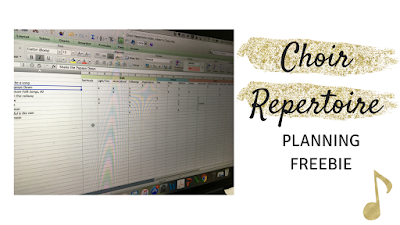This past week, I sat down to choose my choir's repertoire for the spring. I got to thinking about the variety I wanted for the program, and what makes a great selection, so I decided to write with some thoughts that might help you as you choose your choir's repertoire!
A little background: as I wrote about in this post, I have a choir of about 80 or so students in third, fourth, and fifth grade. I see them once a week, for 35 minutes, and we have two concerts at school each year, as well as community events as those arise.
I was a trumpet player all through school, and before my Kodaly training, I literally was in one semester of choir. Ever. So it has taken me quite a while to feel comfortable selecting repertoire, as well as directing the choir! I've gone to several choral sessions throughout the years at conferences, but am definitely not claiming to be a choral expert! Here are some thoughts as you choose choral repertoire:
A little background: as I wrote about in this post, I have a choir of about 80 or so students in third, fourth, and fifth grade. I see them once a week, for 35 minutes, and we have two concerts at school each year, as well as community events as those arise.
I was a trumpet player all through school, and before my Kodaly training, I literally was in one semester of choir. Ever. So it has taken me quite a while to feel comfortable selecting repertoire, as well as directing the choir! I've gone to several choral sessions throughout the years at conferences, but am definitely not claiming to be a choral expert! Here are some thoughts as you choose choral repertoire:
Is it quality?
As Zoltan Kodaly once said, "Only the best is good enough for a child." I think about this a lot as I choose repertoire. I don't want to choose anything that's cute for the sake of cuteness; I want to choose music that is beautiful, that is timeless, that will touch a child's soul.Is it accessible?
Because I only see my choir once a week for thirty-five minutes, I have to choose music that will be accessible in that amount of time. You won't see me choosing many pieces in parallel thirds for that reason! I love to select unison pieces (which can be more difficult than you'd think, as the students really have to have a unified sound), rounds and canons, partner songs, and 2- and 3-part pieces which have melodies and countermelodies that are easy to layer. For example, "Minka," which I mentioned in this post about Christmas selections, has a melody and a countermelody, and "Kookaburra" by Malvar-Keylock and Friedersdorf has three parts which are super easy to layer on top of each other.Do I love the piano accompaniment?
I often will sit down at the piano and play through the piano part (as best as I can). If I love the piano part, chances are, it's a great selection for the choir!Can students extend their musical learning through the song?
My third graders, at this point in the year, only know the do pentatonic scale. This doesn't mean that I only choose music that is in do pentatonic, as I do sometimes introduce my choir members to solfa and rhythms that their peers not in choir haven't learned yet. But I am mindful as I choose the pieces that there are extractable patterns that I could use to help extend their understanding of rhythmic and melodic concepts. Parts of "Old King Cole" by Perry and Perry, for example, could be used to teach/ practice low sol and the extended do pentatonic scale. "Shake the Papaya down," arranged by Dwyer and Waller, could be used to practice syncopa.Can students read the song?
Along those lines, are there parts of the song that students could sight read? Because of the minimized time I have with my choir, I don't have them hold octavos for every single song, but I do like to have at least a couple songs where students have the music in their hands, to sight read, to practice melodic and rhythmic concepts, to learn musical terms such as crescendo and fermata, and to learn how to track their part.Am I choosing a variety of songs?
Have you ever sat in a choir concert in which students sang beautifully, but everything sounded the same? I have, a few times! For this reason, I try to be very mindful that I'm choosing music with a lot of variety: at different tempi, in different languages, and in different styles. Recently, I sat down and created a template to use whenever I'm choosing repertoire, which you can download for free here:The idea is that you can put a "X" under the corresponding columns, and then make sure that there X's in many different boxes across the template. As I was filling mine out, I realized that I had a LOT of folk songs...which is great, but it's also good for students to sing composed songs, so I was able to choose a couple of composed pieces to balance out my program list.
This past spring, I posted in the Kodaly Educators Facebook group, asking people to list their favorite octavos. I typed the information into a Google Doc and then asked them for more input; here it is in case you need some ideas! Thanks so much to the group for the ideas; make sure to join the group, if you haven't already, as it is a very helpful group!
What are your guidelines for choosing repertoire? Feel free to comment below. Happy singing, and happy teaching!




Thanks so much for this timely post! I'm choosing choir songs this week =)
ReplyDeleteWarm wishes and thanks from Anchorage!